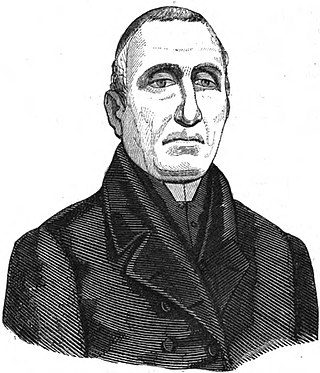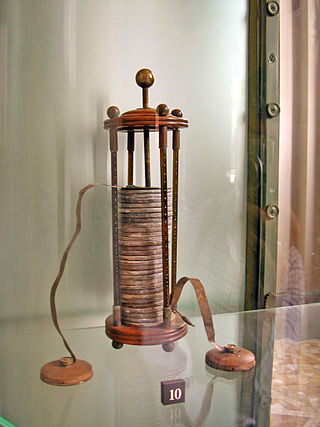
Alessandro Giuseppe Antonio Anastasio Volta was an Italian physicist and chemist who was a pioneer of electricity and power and is credited as the inventor of the electric battery and the discoverer of methane. He invented the voltaic pile in 1799, and reported the results of his experiments in 1800 in a two-part letter to the president of the Royal Society. With this invention Volta proved that electricity could be generated chemically and debunked the prevalent theory that electricity was generated solely by living beings. Volta's invention sparked a great amount of scientific excitement and led others to conduct similar experiments, which eventually led to the development of the field of electrochemistry.

In physics, electromagnetism is an interaction that occurs between particles with electric charge via electromagnetic fields. The electromagnetic force is one of the four fundamental forces of nature. It is the dominant force in the interactions of atoms and molecules. Electromagnetism can be thought of as a combination of electrostatics and magnetism, two distinct but closely intertwined phenomena. Electromagnetic forces occur between any two charged particles, causing an attraction between particles with opposite charges and repulsion between particles with the same charge, while magnetism is an interaction that occurs exclusively between charged particles in relative motion. These two effects combine to create electromagnetic fields in the vicinity of charged particles, which can accelerate other charged particles via the Lorentz force. At high energy, the weak force and electromagnetic force are unified as a single electroweak force.

Electric charge is the physical property of matter that causes it to experience a force when placed in an electromagnetic field. Electric charge can be positive or negative. Like charges repel each other and unlike charges attract each other. An object with no net charge is referred to as electrically neutral. Early knowledge of how charged substances interact is now called classical electrodynamics, and is still accurate for problems that do not require consideration of quantum effects.

Voltage, also known as electric pressure, electric tension, or (electric) potential difference, is the difference in electric potential between two points. In a static electric field, it corresponds to the work needed per unit of charge to move a test charge between the two points. In the International System of Units (SI), the derived unit for voltage is the volt (V).

The voltaic pile was the first electrical battery that could continuously provide an electric current to a circuit. It was invented by Italian chemist Alessandro Volta, who published his experiments in 1799. Its invention can be traced back to an argument between Volta and Luigi Galvani, Volta's fellow Italian scientist who had conducted experiments on frogs' legs. The voltaic pile then enabled a rapid series of other discoveries including the electrical decomposition (electrolysis) of water into oxygen and hydrogen by William Nicholson and Anthony Carlisle (1800) and the discovery or isolation of the chemical elements sodium (1807), potassium (1807), calcium (1808), boron (1808), barium (1808), strontium (1808), and magnesium (1808) by Humphry Davy.
Timeline of electromagnetism and classical optics lists, within the history of electromagnetism, the associated theories, technology, and events.

In electromagnetism and electronics, electromotive force is an energy transfer to an electric circuit per unit of electric charge, measured in volts. Devices called electrical transducers provide an emf by converting other forms of energy into electrical energy. Other electrical equipment also produce an emf, such as batteries, which convert chemical energy, and generators, which convert mechanical energy. This energy conversion is achieved by physical forces applying physical work on electric charges. However, electromotive force itself is not a physical force, and ISO/IEC standards have deprecated the term in favor of source voltage or source tension instead.

Giuseppe Zamboni was an Italian Roman Catholic priest and physicist who invented the Zamboni pile, an early electric battery similar to the voltaic pile.

The Beverly Clock is a clock in the 3rd-floor lift foyer of the Department of Physics at the University of Otago, Dunedin, New Zealand. The clock is still running despite never having been manually wound since its construction in 1864 by Arthur Beverly.

Nicolae Vasilescu Karpen was a Romanian engineer and physicist, who worked in telegraphy and telephony and had achievements in mechanical engineering, elasticity, thermodynamics, long-distance telephony, electrochemistry, and civil engineering.

The Kelvin water dropper, invented by Scottish scientist William Thomson in 1867, is a type of electrostatic generator. Kelvin referred to the device as his water-dropping condenser. The apparatus is variously called the Kelvin hydroelectric generator, the Kelvin electrostatic generator, or Lord Kelvin's thunderstorm. The device uses falling water to generate voltage differences by electrostatic induction occurring between interconnected, oppositely charged systems. This eventually leads to an electric arc discharging in the form of a spark. It is used in physics education to demonstrate the principles of electrostatics.
Electrochemistry, a branch of chemistry, went through several changes during its evolution from early principles related to magnets in the early 16th and 17th centuries, to complex theories involving conductivity, electric charge and mathematical methods. The term electrochemistry was used to describe electrical phenomena in the late 19th and 20th centuries. In recent decades, electrochemistry has become an area of current research, including research in batteries and fuel cells, preventing corrosion of metals, the use of electrochemical cells to remove refractory organics and similar contaminants in wastewater electrocoagulation and improving techniques in refining chemicals with electrolysis and electrophoresis.
This timeline lists significant discoveries in physics and the laws of nature, including experimental discoveries, theoretical proposals that were confirmed experimentally, and theories that have significantly influenced current thinking in modern physics. Such discoveries are often a multi-step, multi-person process. Multiple discovery sometimes occurs when multiple research groups discover the same phenomenon at about the same time, and scientific priority is often disputed. The listings below include some of the most significant people and ideas by date of publication or experiment.

An electric clock is a clock that is powered by electricity, as opposed to a mechanical clock which is powered by a hanging weight or a mainspring. The term is often applied to the electrically powered mechanical clocks that were used before quartz clocks were introduced in the 1980s. The first experimental electric clocks were constructed around the 1840s, but they were not widely manufactured until mains electric power became available in the 1890s. In the 1930s, the synchronous electric clock replaced mechanical clocks as the most widely used type of clock.

The history of electromagnetic theory begins with ancient measures to understand atmospheric electricity, in particular lightning. People then had little understanding of electricity, and were unable to explain the phenomena. Scientific understanding into the nature of electricity grew throughout the eighteenth and nineteenth centuries through the work of researchers such as Coulomb, Ampère, Faraday and Maxwell.

Batteries provided the primary source of electricity before the development of electric generators and electrical grids around the end of the 19th century. Successive improvements in battery technology facilitated major electrical advances, from early scientific studies to the rise of telegraphs and telephones, eventually leading to portable computers, mobile phones, electric cars, and many other electrical devices.

The Zamboni pile is an early electric battery, invented by Giuseppe Zamboni in 1812.

Franklin bells are an early demonstration of electric charge designed to work with a Leyden jar or a Lightning rod. Franklin bells are only a qualitative indicator of electric charge and were used for simple demonstrations rather than research. The bells are an adaptation to the first device that converted electrical energy into mechanical energy in the form of continuous mechanical motion, in this case, the moving of a bell clapper back and forth between two oppositely charged bells.
The frog galvanoscope was a sensitive electrical instrument used to detect voltage in the late 18th and 19th centuries. It consists of a skinned frog's leg with electrical connections to a nerve. The instrument was invented by Luigi Galvani and improved by Carlo Matteucci.

Franklin's electrostatic machine is a high-voltage static electricity-generating device used by Benjamin Franklin in the mid-18th century for research into electrical phenomena. Its key components are a glass globe which turned on an axis via a crank, a cloth pad in contact with the spinning globe, a set of metal needles to conduct away the charge developed on the globe by its friction with the pad, and a Leyden jar – a high-voltage capacitor – to accumulate the charge. Franklin's experiments with the machine eventually led to new theories about electricity and inventing the lightning rod.
















